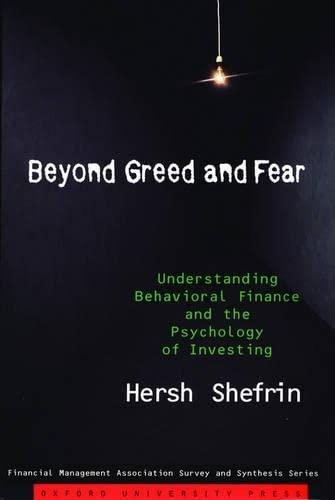Question
Modeling Translate the given scenario into a model: Create an influence chart. List the key (you must determine which values are important) inputs that can
Modeling
Translate the given scenario into a model:
- Create an influence chart.
- List the key (you must determine which values are important) inputs that can be extracted from the information given.
- State any assumptions that you needed to make
(Only answer the above questions. Thank you!)
Greg Johnson needs financial advice and he has come to your team for help. Greg would like to retire in 10 years or sooner, if financially possible. However, he is fearful that he may not meet his retirement goals. He has come to you for an analysis of his current financial position and whether he is on track to retire at age 65 or not, and if not, what options would your team recommend helping him ensure he meets his goals.
Greg is 55 years of age, married with one child. He has been working as a service technician for Xerox for the last 30 years. His wife, Madelyn is 53 and retired at 50. She only worked part time since she married Greg 35 years ago and therefore did not earn a pension. Gregs son, James, is 30 years old and has a family of his own.
Gregs 2020 salary from Xerox is $61,800 (per annum). Every year, Greg receives a cost-of-living adjustment (COLA) of 3%. In addition, he is eligible for year-end bonuses that range from 5% to 15% of his annual salary, dependent upon the performance of his regional office. Last year, Greg earned a bonus of 10% or $6,000.00.
Every year Greg invests $3,000 into an RRSP. He and Madelyn also try to put in most of their net income (gross income less all expenses and taxes deducted) equally between TFSA accounts and RRSPs. Altogether, TFSAs, RRSPs and his LIRA amount to $420,000. These account balances are invested in long-term conservative investment ETFs that are a combination of equity and fixed income securities (40/60 split, respectively). Any new contributions are also allocated in these same proportions. The cumulative average appreciation on these investments is 5% per year. In addition, he earns approximately $3500 per year in dividend and interest income. Also, part of his net worth is a $50,000 rainy-day fund (invested in a short-term money market mutual fund with RBC).
In addition to his retirement assets, Gregs net worth consists of his home (purchase price $275,000 in 2002) in which he put $55,000 down and took out a 25-year mortgage in the amount of $220,000. Today, Gregs current mortgage balance is $88,000 and he estimates that the market value of their home is $350,000. This estimated market value less his current mortgage balance represents the equity in their home. He monthly mortgage payments are $1,200.00 and he and Madelyn have no other outstanding debts. They pay off their credit card charges every month and have a secured personal line-of-credit for $25,000 that they have never had to use.
He has a term life insurance policy with a value of $500,000 and Madelyn as the beneficiary. His monthly premium for this policy is $135.00. This policy terminates when Greg reaches age 70. Even though it carries no cash value, should Greg die while the policy is in effect, the death benefit is paid to his beneficiary, Madelyn.
Gregs goal is to work until he is 65 at the very latest sooner, if financially viable. He wants to ensure that his assets will not only adequately provide for he and Madelyn in their retirement, but also allow them to travel the world. They are both in good health and believe they will live at least into their early 90s. This too is a concern of Gregs. At retirement, he wonders if his assets will last until he and Madelyn reach their early 90s or will his funds run out before then?
Other pieces of information that Greg has provided you for your analysis include the following:
Monthly expenses:
- Food & Household items: $550.00
- Utilities: $200.00 (average)
- Telecom/internet/streaming TV: $250.00
- Entertainment: $250.00
- Travel/Vacations: $ 400.00 (averaged monthly)
- Mortgage: $1200.00
- Insurance (auto, home, & life): $485.00
- Maintenance & Repairs: $350.00 (home & autos)
- Fuel: $200.00 (2 autos)
- Miscellaneous: $275.00
Total estimated monthly expenses: $4160.00
Estimated tax rate applied: 19%
Step by Step Solution
There are 3 Steps involved in it
Step: 1

Get Instant Access to Expert-Tailored Solutions
See step-by-step solutions with expert insights and AI powered tools for academic success
Step: 2

Step: 3

Ace Your Homework with AI
Get the answers you need in no time with our AI-driven, step-by-step assistance
Get Started


